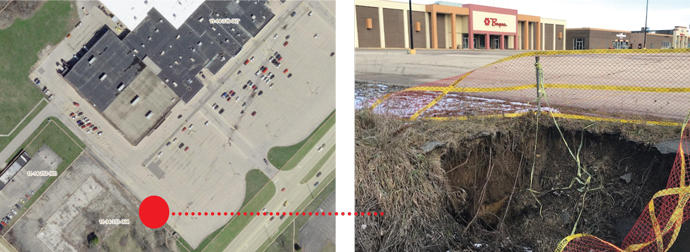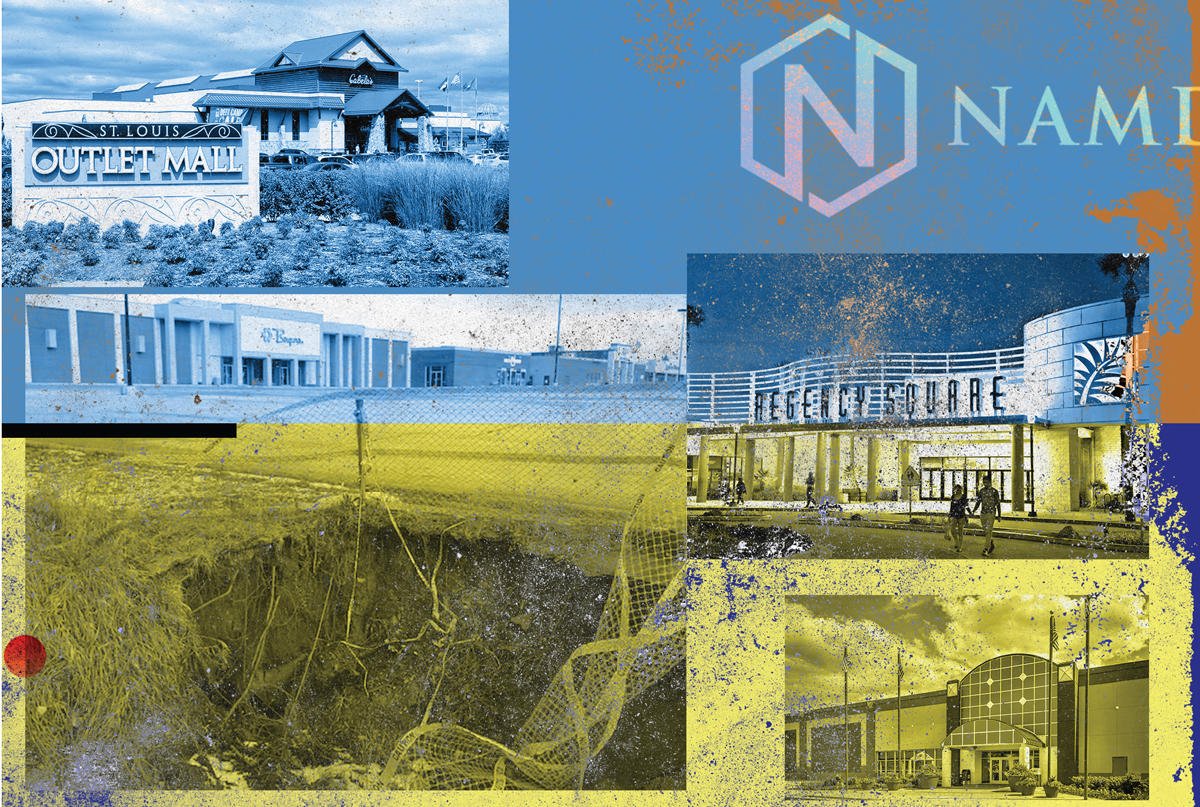At the Regency Square Mall in Jacksonville, Florida, roaches roam freely, the air conditioning is broken and the roof leaks, according to a series of lawsuits filed over the past four years.
But the mall’s owner, Namdar Realty Group, did not disclose any of that to its tenants, a handful of retailers alleged.
When the issue was raised, Namdar painted over the water stains and the problem got worse as mold grew and another leak developed, International Decor Outlet asserted in a 2017 suit.
Namdar “is an absentee landlord with a reputation as a ‘slumlord,’” the home furnishings store’s complaint reads. The lawsuit was later voluntarily dismissed.
In another part of the mall, the leaky roof allegedly made it impossible for a tenant to move in. A certificate of occupancy was never issued, and the leaks caused two electrical fires, according to another lawsuit filed against the property by the Jacksonville Automotive and Motorcycle Museum.
And when the electricity went out in one part of the mall in June 2017, it took Namdar four months to restore power, a local church claimed in a third lawsuit. As a result, a build-up of moisture caused the chiller pipes to rip through the ceiling, destroying the tiles, dry wall and floor, according to the church.
That comes on top of complaints against Namdar and its sister company, Mason Asset Management, from local officials and residents in several regions.
Namdar and Mason, which co-owns and co-manages the Regency Mall and others, declined to comment on specific lawsuits but denied the accusations.
“We feel that we’re doing very good for the communities and the properties that we own within those communities,” said Mason’s president, Elliot Nassim. “Once in a while you come across someone who doesn’t necessarily agree with what you’re doing.”
Despite being hit with allegations of neglect at several of their malls, Namdar and Mason are rapidly growing. With 86 million square feet across more than 400 properties combined, they now stack up against some of the industry’s biggest players. By comparison, Macerich owns 51 million square feet across 47 malls, and Simon Property Group owns 186 million square feet across 250 properties.
“We still believe in [brick and mortar] retail, and we think there’s a place for it,” said Igal Namdar, Namdar’s president.
Through extensive interviews with Namdar and Mason executives and examination of public filings and lawsuits, The Real Deal took a closer look at the two firms and their strategy at a time when many malls are in turmoil.
“Prime locations”
 Based in the upscale enclave of Great Neck, Long Island, Namdar and Mason are both family run.
Based in the upscale enclave of Great Neck, Long Island, Namdar and Mason are both family run.
The companies operate jointly: Namdar handles most of the finances, while Mason focuses on leasing. Some of the properties are owned by one and managed by the other, and some are owned by both.
Curiously, Namdar and Mason continue to fly under the radar. They have been gobbling up properties even as the market for malls shrinks and other owners and operators pull back. In 2019, Namdar bought 30 properties and Mason acquired 23. Last year, Namdar bought 12 more and Mason added eight.
Malls were at one point seen as the future — places where people of all ages could gather and shop under a single roof. But as online shopping grew and consumer habits changed, many malls found themselves plagued by dwindling foot traffic and rising bankruptcies.
When the pandemic hit, those issues were only exacerbated. Dozens of retailers have filed for Chapter 11 in the past year, including mall staples such as J.C. Penney and Ascena Retail Group. Others, like Macy’s and Gap, have decided to pull out of malls altogether.
At the same time, many tenants have simply stopped paying rent, as countless malls struggle to regain their footing.
In New York City, malls lost half a year to the pandemic before being permitted to reopen in September. In Los Angeles, malls got the green light that October after reopening and closing again in mid-July.
For big names, revenue plummeted. Even Simon Property, which has one of the best balance sheets in the business, saw its net income fall to $145.9 million in 2020’s third quarter from $544.3 million in the same period a year earlier.
None of this seems to faze Namdar and Mason executives, who say they’ve survived downturns before. “It doesn’t matter to us if people are selling,” Igal said. “If we see that our business idea works, and we can run these models, and we can fix them up, and we can manage them, and we can bring value, we’ll keep on buying.”
Namdar was founded in 1999, the same year Time named Amazon’s Jeff Bezos Person of the Year. Mason was founded more than 10 years later, as the country was coming out of the Great Recession.
Nassim is the cousin of Igal’s wife. Their joint operation began when Igal started buying small retail locations in Great Neck using money from his family’s jewelry business; Nassim took up the leasing. Nassim brought in the national tenants and managed to fill spaces that brokers couldn’t, Igal said.
“You go in and you don’t know much,” he noted. “You make a lot of mistakes, and you learn from every mistake on the way.”
The two talk every day, brainstorming their next moves, and see each other on weekends. That time is vital now as they navigate the heavy turbulence of the pandemic.
Igal and Nassim’s strategy lately has been similar to that employed by Simon and Brookfield, which have been buying up bankrupt retailers including J.C. Penney and Brooks Brothers. Namdar and Mason have been acquiring smaller, distressed, local retailers, including a Midwest movie theater chain that filed for bankruptcy last year. Namdar also recently hired a director of redevelopment with plans to repurpose some of the partnership’s properties.
“Most of the [malls] are built in prime locations,” Igal said. “So there’s great value there.”
A fading industry
More than 20 percent of U.S. malls will close by 2022, according to a 2017 report by Credit Suisse. Some may die a slow death as stores are shuttered one by one. Others will be demolished by their owners.

Of course, not all may be worth saving. And it may be natural to have issues at some mall locations, especially if there’s not enough capital to make changes, industry sources say. If the ultimate goal is to redevelop the property, criticism can occur.
“Communities often want the world. And then there’s reality,” said Alexander Goldfarb, managing director senior and REIT analyst for Piper Sandler, who declined to comment on Namdar in particular. “So the community may want one thing, but economically, it’s not feasible.”
But in the meantime, according to retail strategist Marshall Kay, malls serve a purpose for the communities that they’re in, regardless of the backlash they may face over their condition. He raised the possibility that another owner might not keep some of Namdar’s malls open at all.
“If Namdar wasn’t the owner of these properties, would it mean that certain areas would be underserved? That’s a question worth considering,” said Kay, who argued that there “isn’t an obligation to revitalize every retail property.”
“What is the alternative for consumers?” he added. “What is the alternative for the retailers who rent from them?”
“Depreciation purposes”
In Mansfield, Ohio, Namdar’s Westpark Shopping Center looks ill.
The canopy is peeling off the building, and its signage has fallen. The overflowing dumpster has become a public nuisance, according to a letter from the city to Namdar last September. A spokesperson for Namdar said it is actively working to fix the property.
It’s not the first time the shopping center has been in trouble. In October 2019, Dollar General received an order to evacuate: The fire alarm system was out of service and needed to be replaced.
At a Namdar property in Sterling, Illinois, photographs show a sinkhole that formed after a storm drainage tube collapsed. The damage may be causing water to infiltrate the city’s sewer system, according to emails between town officials sent throughout 2020 provided to TRD.
Mall employees and customers voiced concerns to the city, but outreach to Namdar went unanswered until the city threatened litigation, according to the emails. Namdar’s spokesperson said the company has worked “diligently” to repair the storm drain and any remaining issues surrounding the collapse.
As Namdar rushes to acquire more properties, some worry that the ones it owns are being left behind.

A sinkhole at the Northland Mall in Sterling, Illinois.
“Over time, you do become what you’re perceived,” Cushman and Wakefield Vice Chair Mark Gilbert said of Namdar in a 2018 interview with Reuters. “I think that in many respects if they don’t define what they’re going to do with these malls in general, then they may get defined by the bad ones.”
At a shuttered mall in Hazelwood, Missouri, near St. Louis, the local newspaper published images of burned-out light bulbs and waist-high grass. The mall looks abandoned, but isn’t.
“We’ve redirected our efforts at the St. Louis Outlet Mall and have since entered into a multiparty agreement to resolve outstanding taxes and assessments,” Namdar’s spokesperson said in a statement.
At the now-shuttered Phillipsburg Mall in New Jersey, following a heavy rain in 2018, the roof of a vacant Sears collapsed, bringing a water pipe down with it, according to police reports.
Namdar’s spokesperson blamed “hastily completed contracting work that Sears had commissioned a number of years back,” before the retailer shut its doors.
“Given that the property was slated for a redevelopment and ultimately would be demolished, this accelerated the plans for the building,” the spokesperson noted.
Upset communities allege that Namdar and Mason are looking to turn a profit by not investing in their malls.
Brad Schrader, Sterling’s superintendent of public works, said he suspects the city is the victim of Namdar using the local mall “for depreciation purposes.”
“We get stuck holding the bag in the end,” he said. “It’s an economic drain on us because they’re not reinvesting and it’s a moral drain on the community, watching something that was once a vibrant center for the community falling into disrepair.”
Smoke and mirrors?
After soaking Florida’s DeSoto Square Mall for management fees, Namdar attempted to sell the property for $30 million, according to a lawsuit filed by the financial services firm ML Holdings in 2018.
Namdar ultimately traded the property to ML Holdings for $25.5 million. But when the new owner took a closer look after the sale, it found things were not as they appeared.
Despite carrying significant expenses for security, waste disposal, landscaping and parking lot repairs on its books, the mall was in poor condition, and its gross income was slashed from $6 million to $4 million, ML Holdings claimed.
Soon after the sale closed, tenants allegedly began to flee.
Namdar had verbally agreed to lower rents for store owners, in some cases to as little as 25 percent of what was reported in leases, while others had been allowed to stay rent-free to prop up occupancy rates, according to the complaint.
“While we cannot say much on the matters related to the Midtown DeSoto Square Mall, it has been made public that we sold the property in early 2017,” Namdar’s spokesperson said.
Over time, ML Holdings fell into default on its loan. The lawsuit contends that the mall should have sold for about $5 million — one-fifth of what the company paid.
That was no accident, said Meyer Silber, ML Holdings’ lawyer in the case against Namdar, which is ongoing.
“Their strategy generally was to suck out as much money from a mall as possible,” said Silber, “and they try to just dump it.”
